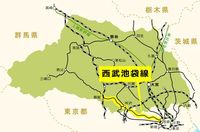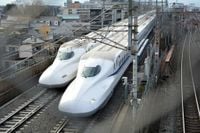On May 2, 2025, travelers across various train lines in Japan experienced significant disruptions due to adverse weather conditions and maintenance issues. The Tobu Tojo Line, the Tokaido Shinkansen, and the Hakubi Line were all impacted, leading to delays and cancellations that left passengers scrambling.
Starting with the Tobu Tojo Line, at approximately 6:45 PM, train services between Kasumigaseki and Wakaba stations were delayed or suspended due to a vehicle inspection. This announcement was made by Tobu Railway, which confirmed that the ongoing inspection affected a number of trains along this route. As passengers awaited updates, many expressed frustration over the lack of timely information regarding the status of their journeys.
Meanwhile, JR Central issued a statement at 4 PM regarding the Tokaido Shinkansen, which runs between Tokyo and Osaka. Heavy rainfall exceeding 40 millimeters per hour was reported between Odawara in Kanagawa Prefecture and Mishima in Shizuoka Prefecture. Due to this severe weather, the company warned that services might be temporarily halted or operated at reduced speeds, depending on the rain's intensity. Travelers were advised to stay informed through the JR Central website as conditions evolved.
Despite the earlier concerns, by 6 PM, JR Central reassured passengers that the Tokaido Shinkansen was operating as usual. This announcement likely provided some relief to those traveling during the busy holiday season, as all seats on the Nozomi trains were reserved until May 6, 2025, due to increased passenger volume during the consecutive holidays.
In the west of the country, JR West reported delays on the Hakubi Line, specifically between Hiyazu Station and Mikawa Station, caused by a fallen tree. The Limited Express Yakumo No. 12, bound for Okayama, faced a delay of approximately 70 minutes, while the Yakumo No. 14, also heading to Okayama, was delayed by about 40 minutes. Passengers were urged to check the JR West website for the latest updates, as the situation was subject to change.
As the day progressed, the combination of heavy rainfall and maintenance checks created a ripple effect across the rail network, highlighting the challenges of maintaining smooth operations during adverse weather. Commuters and travelers alike were reminded of the importance of staying informed and planning ahead, especially during peak travel times.
These incidents serve as a reminder of the complexities involved in railway operations, particularly in regions prone to heavy rainfall. The swift response from rail companies in communicating delays and potential service changes demonstrates their commitment to passenger safety, even amidst challenging circumstances.
As the situation continues to evolve, rail operators are expected to monitor weather conditions closely and adjust services accordingly to ensure the safety and comfort of all passengers. Travelers are encouraged to remain patient and flexible with their travel plans as they navigate the disruptions caused by these unforeseen circumstances.
In conclusion, while the disruptions on May 2, 2025, were inconvenient for many, they also showcased the resilience and adaptability of Japan's rail system in the face of natural challenges. Passengers are advised to stay updated through official channels and to prepare for potential delays when traveling during inclement weather.





